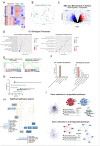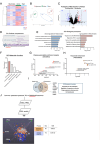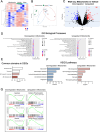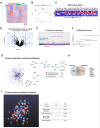Mitochondrial transplantation normalizes transcriptomic and proteomic shift associated with ischemia reperfusion injury in neonatal hearts donated after circulatory death
- PMID: 39732955
- PMCID: PMC11682362
- DOI: 10.1038/s41598-024-82578-2
Mitochondrial transplantation normalizes transcriptomic and proteomic shift associated with ischemia reperfusion injury in neonatal hearts donated after circulatory death
Abstract
Heart transplantation remains the ultimate treatment strategy for neonates and children with medically refractory end-stage heart failure and utilization of donors after circulatory death (DCD) can expand th donor pool. We have previously shown that mitochondrial transplantation preserves myocardial function and viability in neonatal swine DCD hearts to levels similar to that observed in donation after brain death (DBD). Herein, we sought to investigate the transcriptomic and proteomic pathways implicated in these phenotypic changes using ex situ perfused swine hearts. Pathway analysis showed that ATP binding, voltage-gated K channel activity involved in cardiac cell muscle contraction and ribosomal RNA biogenesis were upregulated in the mitochondrial transplantation group, while mitochondria were the predicted source. Promotion of ribosome biogenesis and downregulation of apoptosis were the overlapping mechanisms between transcriptomic and proteomic alterations. Moreover, we showed that mitochondrial transplantation modulates ischemic transcriptomic and proteomic profiles to that of non-ischemia through the mitochondria. Replication of these findings in human in vivo experiments is warranted.
Keywords: Donation after cardiac death; Ex situ heart perfusion; Mitochondrial transplantation; Neonatal; Proteomic; RNA sequencing.
© 2024. The Author(s).
Conflict of interest statement
Declarations. Competing interests: The authors declare no competing interests.
Figures






Similar articles
-
Mitochondrial transplantation for myocardial protection in ex-situ‒perfused hearts donated after circulatory death.J Heart Lung Transplant. 2020 Nov;39(11):1279-1288. doi: 10.1016/j.healun.2020.06.023. Epub 2020 Jun 29. J Heart Lung Transplant. 2020. PMID: 32703639
-
Mitochondrial transplantation preserves myocardial function and viability in pediatric and neonatal pig hearts donated after circulatory death.J Thorac Cardiovasc Surg. 2024 Jan;167(1):e6-e21. doi: 10.1016/j.jtcvs.2023.05.010. Epub 2023 May 20. J Thorac Cardiovasc Surg. 2024. PMID: 37211245
-
Ischemia and reperfusion injury to mitochondria and cardiac function in donation after circulatory death hearts- an experimental study.PLoS One. 2020 Dec 28;15(12):e0243504. doi: 10.1371/journal.pone.0243504. eCollection 2020. PLoS One. 2020. PMID: 33370296 Free PMC article.
-
Heart transplantation following donation after circulatory death: Expanding the donor pool.J Heart Lung Transplant. 2021 Sep;40(9):882-889. doi: 10.1016/j.healun.2021.03.011. Epub 2021 Apr 8. J Heart Lung Transplant. 2021. PMID: 33994229 Review.
-
Transplantation of Hearts Donated after Circulatory Death.Front Cardiovasc Med. 2018 Feb 13;5:8. doi: 10.3389/fcvm.2018.00008. eCollection 2018. Front Cardiovasc Med. 2018. PMID: 29487855 Free PMC article. Review.
Cited by
-
Exploring mitochondrial health and transplantation strategies in DCD heart transplantation: a systematic review.J Transl Med. 2025 Jul 14;23(1):789. doi: 10.1186/s12967-025-06805-8. J Transl Med. 2025. PMID: 40660219 Free PMC article.
-
Biotechnological approaches and therapeutic potential of mitochondria transfer and transplantation.Nat Commun. 2025 Jul 1;16(1):5709. doi: 10.1038/s41467-025-61239-6. Nat Commun. 2025. PMID: 40593725 Free PMC article. Review.
References
-
- Alemany, V. S. et al. Mitochondrial transplantation preserves myocardial function and viability in pediatric and neonatal pig hearts donated after circulatory death. J Thorac Cardiovasc Surg167, e6–e21 (2024). - PubMed
-
- Guariento, A. et al. Mitochondrial transplantation for myocardial protection in ex-situ-perfused hearts donated after circulatory death. J Heart Lung Transplant39, 1279–1288 (2020). - PubMed
-
- Nobori, K. et al. ATF3 inhibits doxorubicin-induced apoptosis in cardiac myocytes: A novel cardioprotective role of ATF3. J Mol Cell Cardiol34, 1387–1397 (2002). - PubMed
MeSH terms
Substances
Grants and funding
LinkOut - more resources
Full Text Sources

